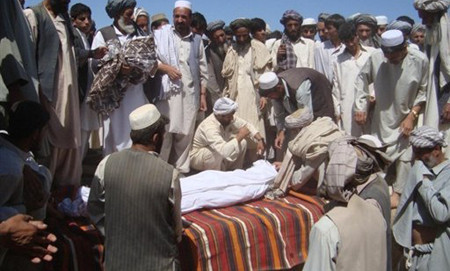By Fahim Abed & Mujib Mashal
KABUL, Afghanistan — The number of civilians killed by Afghan and American airstrikes is rising, the United Nations said Tuesday, as the Afghan government increasingly relies on airpower in its fight against a resurgent Taliban.
The United Nations mission in Afghanistan said 21 civilians were killed in two airstrikes last weekend and urged all parties to the conflict to take stronger measures to protect civilians.
After the release of the United Nations statement, an airstrike on Tuesday in the Chardara district of Kunduz Province killed three more people, a 45-year-old woman and two teenage girls, according to Sher Mohammed, the husband of the woman who died.
On Wednesday, angry residents carried the bodies of two of the victims to the city of Kunduz, the provincial capital, and chanted slogans against the government and American forces.
“They martyred three women. My son, who is a university student in economics faculty, and my daughter, Atifa, are wounded — they are in a serious condition in hospital currently,” said Mr. Mohammed, a teacher in the village school. “They destroyed my life.”


More than 150 residents of Chahar Dara district in northern Kunduz were killed and 20 others wounded in an air strike by NATO-led forces on September 4, 2009.
Its ground forces stretched as they fight insurgents in about two dozen of the country’s 34 provinces, the Afghan government relies heavily on airstrikes to push back against Taliban gains. Although American forces conduct most of the strikes, the Afghan Air Force is increasingly involved, carrying out as many as two dozen strikes a day in recent weeks.
The increase in the use of Afghan airpower has brought more claims of civilian casualties. In April, Afghan military helicopters bombed a Kunduz Province mosque, killing at least 70 people and wounding 30 others, according to a local official.
In the first six months of the year, the United Nations mission said on Tuesday, airstrikes killed 149 people and injured 204, a 52 percent increase from the same period last year.
“It is of particular concern that women and children made up more than half of all aerial-attack civilian casualties,” the mission said.
The deadliest of the recent incidents took place on Sunday in Wardak Province, just south of Kabul, killing 12 people from the same family, according to a separate United Nations statement on Tuesday. Local residents and tribal elders said 14 people had been killed. The attack happened in the Jaghato district, and 10 of the victims were children between the ages of 6 and 15, the United Nations said.
On Saturday, another attack in the Tagab district of Kapisa Province killed at least nine members of the same family and wounded six others, according to the United Nations and a resident named Kefayatullah, whose sister’s house was bombed. The area is controlled by the Taliban, according to Kefayatullah, who, like most Afghans, goes by one name.
“I don’t know that it was the Afghan forces or the foreign troops, but they killed my sister and her family,” he said.
The provincial authorities in both Kapisa and Wardak denied that military operations had caused any civilian casualties there, saying only large numbers of Taliban militants had been targeted. But Ghafoor Ahmad Javed, a spokesman for the Afghan Ministry of Defense, said reports of civilian casualties were being investigated in both provinces.
With the Afghan and American forces working closely together and data on Afghan airstrikes often vague, it can be difficult to determine precisely who has carried out which airstrike. The United Nations mission estimated that in the first half of the year, Afghan forces were responsible for 52 percent of the civilian casualties from aerial attacks, compared with 45 percent for international military forces and 3 percent for pro-government forces.
Aerial attacks accounted for 7 percent of all civilian casualties, the United Nations said.
American forces in Afghanistan confirmed that they had provided air support to pro-government militia in Kapisa Province at the request of Afghan forces, but they said it was militia members who had been mistakenly injured.
“U.S. helicopters were present to provide the support and immediately came under fire from the local militia and returned fire in self-defense,” said Cmdr. Grant Neeley, the spokesman for United States forces in Afghanistan. Six militia members were wounded, he said.
“As the fog of war lifted and it became clear the militia had fired in error, the wounded militia members were airlifted and they are currently receiving treatment in a U.S. hospital,” he said.
Regarding the aerial attack in Wardak Province, Commander Neeley said American forces had no indication of civilian casualties in the area.
Fatima Faizi contributed reporting from Kabul, and Najim Rahim from Mazar-i-Sharif.



